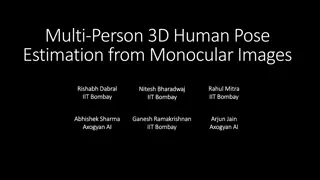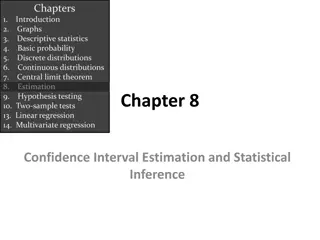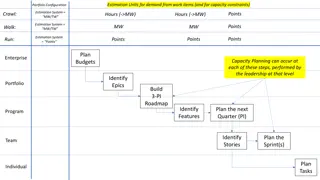Software Project Planning and Estimation Techniques
The chapter discusses software project planning and estimation techniques, focusing on an example of LOC-based estimation for a computer-aided design application. It explores preliminary statements of software scope, major software functions, and the use of decomposition techniques for estimating lines of code (LOC) for each function.
Download Presentation

Please find below an Image/Link to download the presentation.
The content on the website is provided AS IS for your information and personal use only. It may not be sold, licensed, or shared on other websites without obtaining consent from the author.If you encounter any issues during the download, it is possible that the publisher has removed the file from their server.
You are allowed to download the files provided on this website for personal or commercial use, subject to the condition that they are used lawfully. All files are the property of their respective owners.
The content on the website is provided AS IS for your information and personal use only. It may not be sold, licensed, or shared on other websites without obtaining consent from the author.
E N D
Presentation Transcript
Software engineering Software engineering Chapter 5 Software Project Planning By: Lecturer By: Lecturer Raoof Raoof Talal Talal
5-6-1 an Example of LOC-Based Estimation As an example of LOC and FP problem-based estimation techniques, let us consider a software package to be developed for a computer-aided design application for mechanical components. A review of the System Specification indicates that the software is to execute on an engineering workstation and must interface with various computer graphics peripherals including a mouse, digitizer, high resolution color display and laser printer.
Using the System Specification as a guide, a preliminary statement of software scope can be developed: The CAD software will accept two- and three-dimensional geometric data from an engineer. The engineer will interact and control the CAD system through a user interface that will exhibit characteristics of good human/machine interface design. All geometric data and other supporting information will be maintained in a CAD database. Design analysis modules will be developed to produce the required output, which will be displayed on a variety of graphics devices. The software will be designed to control and interact with peripheral devices that include a mouse, digitizer, laser printer, and plotter.
This statement of scope is preliminaryit is not bounded. Every sentence would have to be expanded to provide concrete detail and quantitative bounding. For example, before estimation can begin the planner must determine what "characteristics of good human/machine interface design" means or what the size and sophistication of the "CAD database" are to be.
For our purposes, we assume that further refinement has occurred and that the following major software functions are identified: User interface and control facilities (UICF) Two-dimensional geometric analysis (2DGA) Three-dimensional geometric analysis (3DGA) Database management (DBM) Computer graphics display facilities (CGDF) Peripheral control function (PCF) Design analysis modules (DAM)
Following the decomposition technique for LOC, an estimation table, shown in Figure 5.2, is developed. A range of LOC estimates is developed for each function. For example, the range of LOC estimates for the 3D geometric analysis function is: Optimistic= 4600 LOC. Most likely=6900 LOC. Pessimistic=8600 LOC. Applying Equation (5-1), the expected value for the 3D geometric analysis function is 6800 LOC. Other estimates are derived in a similar fashion.
By summing vertically in the estimated LOC column, an estimate of 33,200 lines of code is established for the CAD system.A review of historical data indicates that: The organizational average productivity for systems of this type is 620 LOC/pm. Based on a burdened labor rate of $8000 per month. Therefore The cost per line of code is approximately $13. (8000$ pm/620 LOC/ pm) Based on the LOC estimate and the historical productivity data: The total estimated project cost is $431,000. (13$ * 33200) The estimated effort is 54 person-months. (33200/620)
5-6-2 an Example of FP-Based Estimation Decomposition for FP-based estimation focuses on information domain values rather than software functions. Referring to the function point calculation table presented in Figure 5.3, the project planner estimates inputs, outputs, inquiries, files, and external interfaces for the CAD software. For the purposes of this estimate, the complexity weighting factor is assumed to be average. Figure 5.3 presents the results of this estimate.
Each of the complexity weighting factors is estimated and the complexity adjustment factor is computed as described in Chapter 4: Factor Value Backup and recovery 4 Data communications 2 Distributed processing 0 Performance critical 4 Existing operating environment 3
On-line data entry 4 Input transaction over multiple screens 5 Master files updated on-line 3 Information domain values complex 5 Internal processing complex 5 Code designed for reuse 4 Conversion/installation in design 3 Multiple installations 5 Application designed for change 5 Total 52 Complexity adjustment factor 1.17
Finally, the estimated number of FP is derived: FP estimated = count-total X [0.65 + 0.01 X (Fi)] FP estimated = 374.4=375 The organizational average productivity for systems of this type is 6.5 FP/pm. Based on a burdened labor rate of $8000 per month; the cost per FP is approximately $1230. Based on the LOC estimate and the historical productivity data, the total estimated project cost is $461,000 and the estimated effort is 58 person-months.
5-7 Empirical Estimation Models An estimation model for computer software uses empirically derived formulas to predict effort as a function of LOC or FP. Values for LOC or FP are estimated using the approach described in Sections 5.6.1 and 5.6.2. But instead of using the tables described in those sections, the resultant values for LOC or FP are plugged into the estimation model. The empirical data that support most estimation models are derived from a limited sample of projects. For this reason, no estimation model is appropriate for all classes of software and in all development environments.
A typical estimation model is derived using regression analysis on data collected from past software projects. The overall structure of such models takes the form E = A + B X (ev)C ...(5-2) Where A, B, and C are empirically derived constants. E is effort in person-months. ev is the estimation variable (either LOC or FP).
In addition to the relationship noted in Equation (5-2), the majority of estimation models have some form of project adjustment component that enables E to be adjusted by other project characteristics (e.g., problem complexity, staff experience, development environment). Among the many LOC-oriented estimation models proposed in the literature are
FP-oriented models have also been proposed. These include A quick examination of these models indicates that each will yield a different result for the same values of LOC or FP. The implication is clear. Estimation models must be calibrated for local needs!
5-8 the Make/Buy Decision In many software application areas, it is often more cost effective to acquire than develop computer software. Software engineering managers are faced with a make/buy decision that can be further complicated by a number of acquisition options: (1) Software may be purchased (or licensed). (2) Software components may be acquired and then modified and integrated to meet specific needs. (3) Software may be custom built by an outside contractor to meet the purchaser's specifications.
In the final analysis, the make/buy decision is made based on the following conditions: (1) Will the delivery date of the software product be sooner than that for internally developed software? (2) Will the cost of acquisition plus the cost of customization be less than the cost of developing the software internally? (3) Will the cost of outside support (e.g., a maintenance contract) be less than the cost of internal support?
5-8-1 Creating a Decision Tree The steps just described can be augmented using statistical techniques such as decision tree analysis. For example, Figure 5.4 depicts a decision tree for a software based system, X. In this case, the software engineering organization can: (1) Build system X from scratch. (2) Reuse existing components to construct the system. (3) Buy an available software product and modify it to meet local needs. (4) Contract the software development to an outside vendor.
If the system is to be built from scratch, there is a 70 percent probability that the job will be difficult. Using the estimation techniques discussed earlier in this chapter, the project planner projects that a difficult development effort will cost $450,000. A "simple" development effort is estimated to cost $380,000. The expected value for cost, computed along any branch of the decision tree, is
Expected cost = (path probability)i X (estimated path cost)i Where i is the decision tree path. For the build path, Expected cost build = 0.30 ($380K) + 0.70 ($450K) = $429K Following other paths of the decision tree, the projected costs for reuse, purchase and contract, under a variety of circumstances, are also shown. The expected costs for these paths are:
Expected cost reuse = 0.40 ($275K) + 0.60 [0.20($310K) + 0.80($490K)] = $382K Expected cost buy = 0.70($210K) + 0.30($400K)] = $267K Expected cost contract = 0.60($350K) + 0.40($500K)] = $410K Based on the probability and projected costs that have been noted in Figure 5.4, the lowest expected cost is the "buy" option.























